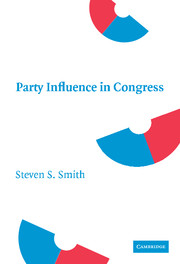Book contents
- Frontmatter
- Contents
- Acknowledgments
- 1 Introduction
- 2 The Microfoundations of Theories of Congressional Parties
- 3 The Types and Sources of Party Influence
- 4 The Search for Direct Party Effects
- 5 Recent Theories of Party Influence: Cartel and Conditional Party Government Theory
- 6 Revisiting Pivotal and Party Politics
- 7 Reexamining the Direct and Indirect Influence of Party in the House and Senate
- 8 More Than a Conclusion
- Appendix
- References
- Index
7 - Reexamining the Direct and Indirect Influence of Party in the House and Senate
Published online by Cambridge University Press: 05 June 2012
- Frontmatter
- Contents
- Acknowledgments
- 1 Introduction
- 2 The Microfoundations of Theories of Congressional Parties
- 3 The Types and Sources of Party Influence
- 4 The Search for Direct Party Effects
- 5 Recent Theories of Party Influence: Cartel and Conditional Party Government Theory
- 6 Revisiting Pivotal and Party Politics
- 7 Reexamining the Direct and Indirect Influence of Party in the House and Senate
- 8 More Than a Conclusion
- Appendix
- References
- Index
Summary
The leading theories of congressional parties, CPG and cartel theory, have different emphases and both compatible and incompatible predictions for observed voting behavior. Pivotal politics theory predicts yet another set of expectations for floor behavior. The three theories have not been tested using a common methodology until recently (Lawrence et al. 2005, 2006). In this chapter, we report the results of that work.
The studies examined in the chapter differ from previous work in several ways:
The empirical analysis considers roll-call behavior aggregated over Congresses and for individual legislators. The examination of individual legislators, as opposed to aggregated roll rates or other measures of group or party behavior, is essential to testing propositions of all three theories;
the analysis considers both symmetric (both parties potentially exercising influence) and asymmetric (the majority party exercising influence) forms of party influence; and
the analysis includes both House and Senate, which gives some basis for evaluating the importance of the Reed rules in the House and other potential sources of difference between the two houses of Congress.
Including the Senate requires that we give consideration to the institutional conditions that create stability in majority party agenda control. It is the interaction of institutional rules and partisan considerations that generate the kind and strength of party influence that we observe in the House and Senate. Party considerations are no more fundamental than institutional considerations. Historically, chamber rules and practices arise interactively with party mechanisms, each conditioning the development of the other.
- Type
- Chapter
- Information
- Party Influence in Congress , pp. 177 - 203Publisher: Cambridge University PressPrint publication year: 2007



